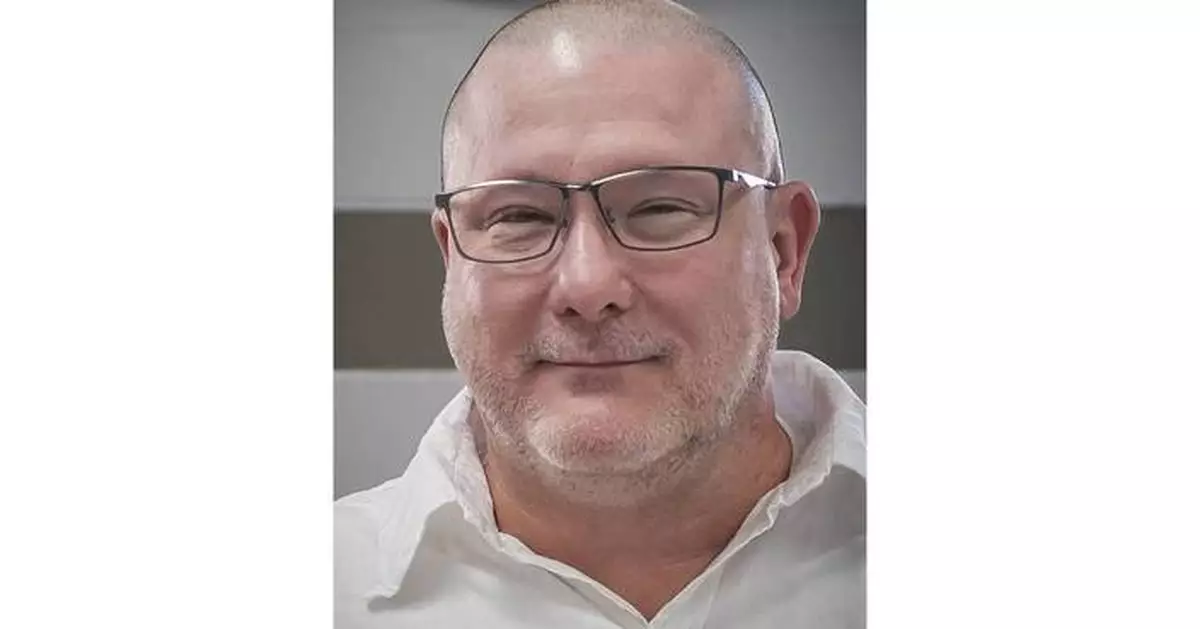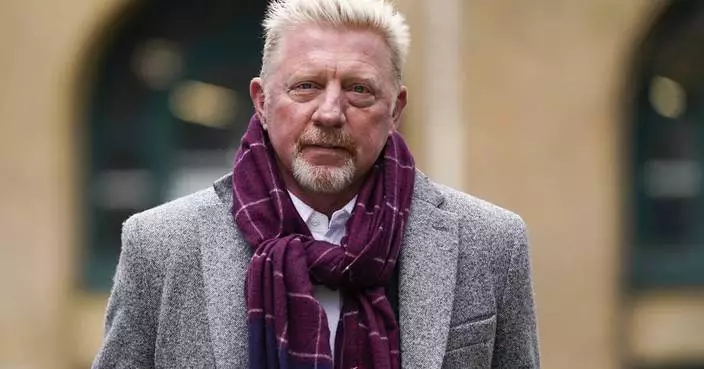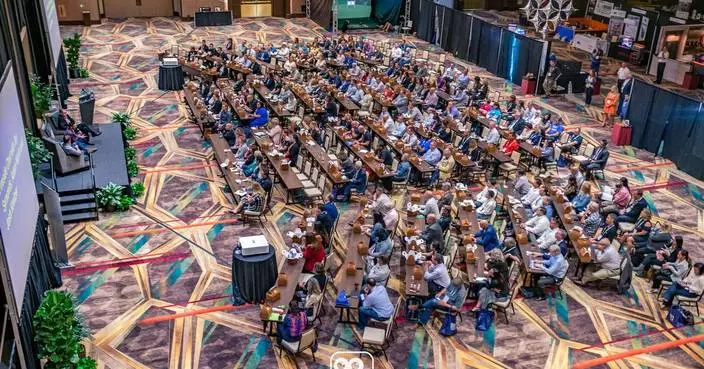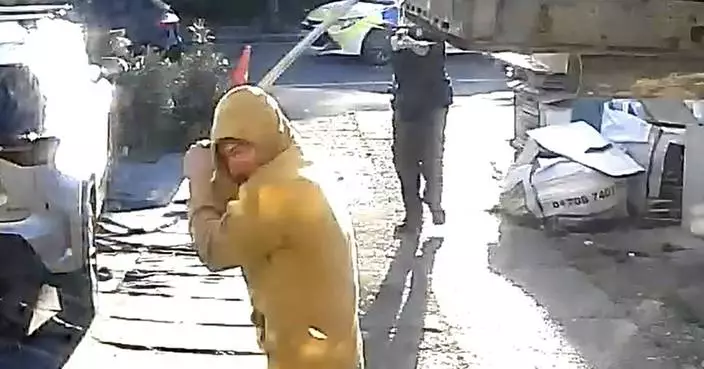ST. LOUIS (AP) — Missouri's execution protocol allows for “surgery without anesthesia” if the typical process of finding a suitable vein to inject the lethal drug doesn't work, lawyers for a death row inmate say in an appeal aimed at sparing his life.
Brian Dorsey, 52, is scheduled for execution Tuesday for killing his cousin and her husband at their central Missouri home in 2006. His attorneys are seeking clemency from Gov. Mike Parson and have several appeals pending.
A federal court appeal focuses on how Missouri injects the fatal dose of pentobarbital. The written protocol calls for insertion of primary and secondary intravenous lines. But it offers no guidance on how far the execution team can go to find a suitable vein, leaving open the possibility of an invasive “cutdown procedure,” Dorsey's attorneys say.
The procedure involves an incision that could be several inches wide and several inches deep. Forceps are used to tear tissue away from a vein that becomes the injection point.
“It's surgery,” said Arin Brenner, a federal public defender and one of the attorneys representing Dorsey. “It would be surgery without anesthesia.”
Brenner said Dorsey faces a higher-than-normal risk of needing a cutdown because he is obese. His veins also might be compromised because he is diabetic and a former IV drug user.
A spokesperson for Attorney General Andrew Bailey didn't comment but referred to the state's response to the appeal.
“Cut-down procedures are rarely, if ever, used under Missouri’s execution protocol,” the response stated. “And in the event that a cut-down procedure were necessary, medical personnel have access to pain relieving medications.”
Medication would be inadequate and if the procedure is necessary, Dorsey should receive a local anesthetic, said Megan Crane, another attorney for him.
“It is extremely painful," Crane said. “Even if given an oral pain relief or an opioid, that will not relieve the pain.”
Lawyers for Dorsey say use of the surgical procedure would violate his constitutional guarantee against cruel and unusual punishment and also his right to religious freedom, because it would prevent him from having meaningful interaction with his spiritual adviser, including the administration of last rites.
The issue isn't theoretical. In Idaho, the scheduled execution of serial killer Thomas Eugene Creech in February was halted after a medical team unsuccessfully tried eight times establish an IV. It is unclear whether, when or how the state might try again to execute him.
Missouri's execution process is shrouded in secrecy, so it's impossible to know if, or how often, cutdown procedures have been required. No independent observer sees the IV line inserted. The spiritual adviser doesn't enter the room until the preparation is complete. Witnesses sit in dark rooms with curtains drawn until corrections officers open them seconds before the drug is injected.
Attorneys for Dorsey wonder if a cutdown procedure was used in January 2023 when Amber McLaughlin was executed. It was believed to be the first execution of an openly transgender person in the U.S.
The Rev. Lauren Bennett of St. Louis served as McLaughlin's spiritual adviser. She recalled McLaughlin saying, “Ouch, ouch, ouch. It hurts," but said McLaughlin was unable to explain the cause of her pain before her death.
Issues with the IV have been problematic in executions elsewhere.
In 2014, Oklahoma inmate Clayton Lockett was declared dead 43 minutes after his execution began, at times writhing in pain and clenching his teeth through the process. A state investigation showed that the execution team repeatedly failed to insert an IV line in his arms, jugular vein, foot and subclavian vein in the upper torso, before eventually running a line through a vein in Lockett’s groin.
The review found that Lockett died after the line came loose, and that the deadly chemicals were pumped into the tissue surrounding the injection site instead of directly into his bloodstream. There is no indication in the report that Lockett was ever given an anesthetic.
In 2022, it took more than three hours to execute Joe Nathan James Jr. in Alabama. The state said the process was delayed because of difficulties establishing an IV line. Dr. Joel Zivot, a professor of anesthesiology at Emory University and an expert on lethal injection who witnessed the private autopsy, said he saw “multiple puncture sites on both arms” and two incisions in the middle of the arm, which he said were indications of efforts to perform a cutdown. It's unclear if he received anesthesia.
Messages were left Friday with corrections officials in Oklahoma and Alabama.
Dorsey, formerly of Jefferson City, was convicted of killing his cousin, Sarah Bonnie, and her husband, Ben, on Dec. 23, 2006, at their home near New Bloomfield. Prosecutors said that earlier that day, Dorsey called Sarah Bonnie seeking to borrow money to pay two drug dealers who were at his apartment.
Dorsey went to the Bonnies’ home that night. After they went to bed, Dorsey took a shotgun from the garage and killed both of them before sexually assaulting Sarah Bonnie’s body, prosecutors said.
Sarah Bonnie’s parents found the bodies the next day. The couple’s 4-year-old daughter was unhurt.
In the clemency petition, 72 current and former state correctional officers asked Parson, a Republican and a former county sheriff, to commute Dorsey’s sentence to life in prison, citing his virtually spotless record of good behavior while in prison.
“The Brian I have known for years could not hurt anyone,” one officer wrote. “The Brian I know does not deserve to be executed.”
A spokesperson said Parson is still reviewing the clemency request.
An appeal to the U.S. Supreme Court centers on the $12,000 flat fee for Dorsey's court-appointed trial attorneys. The appeal argues that with the flat fee, his lawyers had a financial incentive to resolve the case quickly. They encouraged Dorsey to plead guilty, but with no demand that prosecutors agree to life in prison instead of the death penalty.
Dorsey's attorneys also had asked the Missouri Supreme Court to stay the execution on the grounds that the Department of Corrections' acting director, Trevor Foley, has not been confirmed by the state Senate and is therefore unqualified to oversee an execution. The court denied that request Friday.
AP reporter Sean Murphy in Oklahoma City contributed.
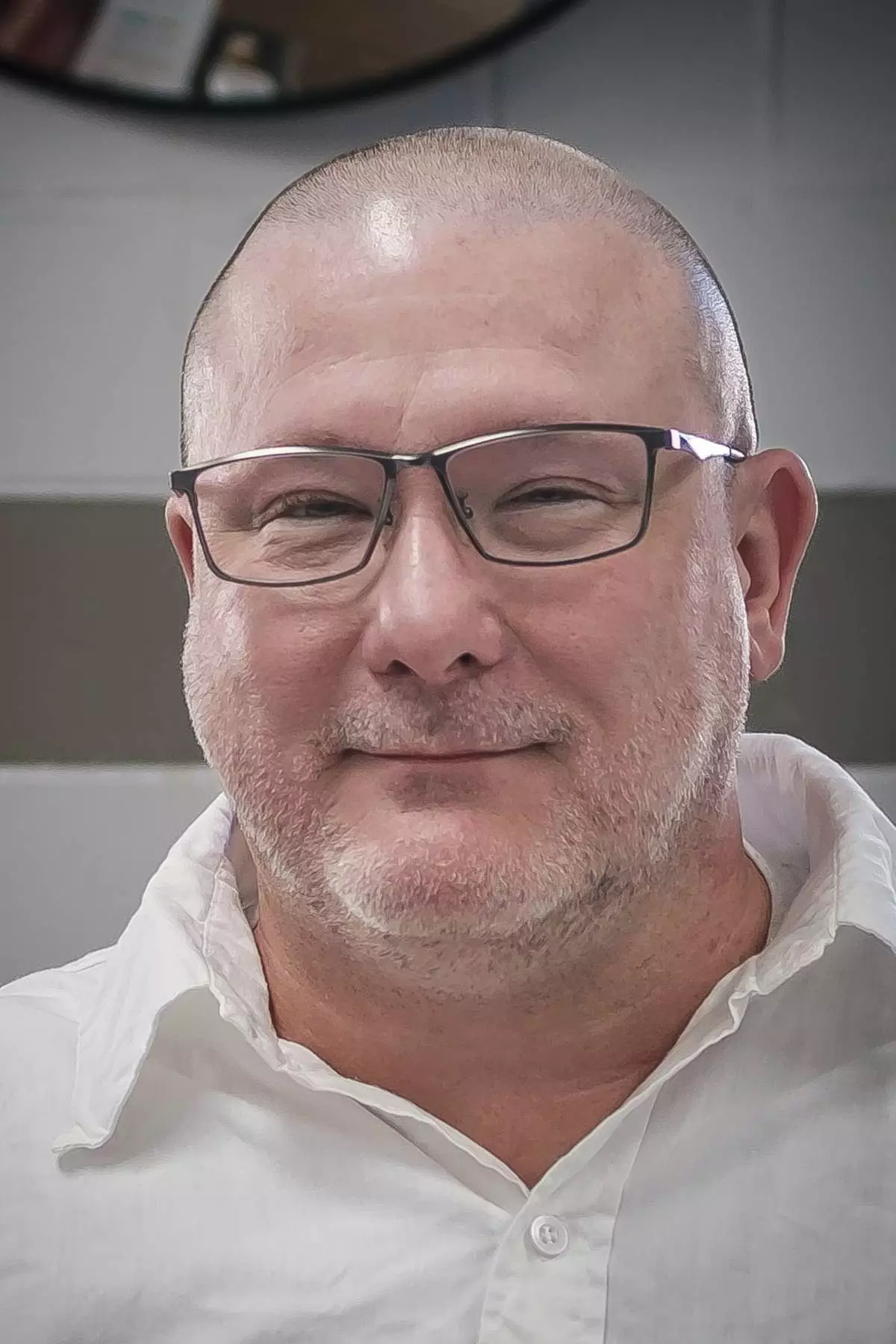
A photo released by the Federal Public Defender, shows inmate Brian Dorsey at the Potosi Correctional Center, Washington County, Missouri. Dorsey is scheduled to be executed Tuesday, April 9, 2024, for killing two people in 2006. (Jeremy Weis, Federal Public Defender via AP)

A photo released by the Federal Public Defender, shows inmate Brian Dorsey at the Potosi Correctional Center, Washington County, Missouri. Dorsey is scheduled to be executed Tuesday, April 9, 2024, for killing two people in 2006. (Jeremy Weis, Federal Public Defender via AP)
Campus police spokesperson Marc Lovicott said four officers were injured Wednesday as police tried to remove protesters’ tents from a central square at the University of Wisconsin in Madison.
Lovicott said a state trooper was hit in the head with a skateboard and three sheriff’s deputies suffered injuries “directly related to the physical resistance from protesters.” At least a dozen people were arrested.
Police removed all but one tent while clashing with the demonstrators. But scores of protesters resumed chanting and, a few hours later, had erected more tents on the square.
Lovicott said police plan to continue monitoring the protests.
Currently:
— Dueling protesters clash at UCLA hours after police clear pro-Palestinian demonstration at Columbia
— Student protesters reach a deal with Northwestern University that sparks criticism from all sides
— How Columbia University became the driving force behind protests over the war in Gaza
— Trump’s comparison of student protests to Jan. 6 is part of effort to downplay Capitol attack
Here's the latest:
Columbia University’s president released a statement Wednesday morning to members of the college community outlining why she called in police the night before.
Nemat Shafik said protesters taking over an administration building on campus early Tuesday was a “drastic escalation” of the encampment at the college, which “pushed the University to the brink, creating a disruptive environment for everyone and raising safety risks to an intolerable level.”
Shafik, who goes by Minouche, acknowledged the school has a “long and proud” history of activism on campus, but argued those occupying the building committed “acts of destruction, not political speech.”
“I know I speak for many members of our community in saying that this turn of events has filled me with deep sadness. I am sorry we reached this point,” she wrote.
Classes have been canceled Wednesday at the University of California, Los Angeles.
UCLA announced the class cancelation on the social media site X, stating: “Due to the distress caused by the violence that took place on Royce Quad late last night and early this morning, all classes are cancelled today. Please avoid the Royce Quad area.”
The clashes at UCLA took place around a tent encampment built by pro-Palestinian protesters. Counter protesters tried to pull down a line of parade barricades, plywood and wooden pallets at the edge of the camp.
Police at two campuses in Arizona have cleared out encampments and arrested pro-Palestinian protesters.
Several people were arrested by police in riot gear early Wednesday at the University of Arizona in Tucson after President Robert Robbins directed school officials to “immediately enforce campus use policies.”
And about 20 people were arrested at Northern Arizona University in Flagstaff on Tuesday night on trespassing charges. Police dismantled a small fence made of chicken wire as well as nearly two dozen tents.
Campus police spokesperson Marc Lovicott said at least a dozen people have been arrested at the University of Wisconsin in Madison as police removed tents erected by protesters.
Police pushed into the protesters with shields Wednesday morning, resulting in a scrum. Protesters chanted “students hold your ground” and “long live Palestine.”
Police have removed all but one of the tents that protesters erected. The protesters’ tents and belongings were loaded into a dump truck.
The university said camping is prohibited under campus policy and state law.
New York City Mayor Eric Adams says about 300 people were arrested in police crackdowns on pro-Palestinian protests at Columbia University and City College.
Adams, a Democrat who was formerly a police captain, insisted that while the people who entered Columbia’s Hamilton Hall included students, “It was led by individuals who were not affiliated with the university.”
“There is a movement to radicalize young people. And I’m not going to wait until it is done to acknowledge the existence of it,” Adams said Wednesday morning.
Police were removing an encampment of pro-Palestinian protesters at the University of Wisconsin’s Madison campus and have taken away several protesters.
Several police officers arrived at the encampment on the campus’ Library Mall around 7 a.m. Wednesday and played a recorded message on a loop saying it was a final warning and that protesters were in violation of university code, WISC-TV reported.
About 20 minutes later, nearly 60 police officers, some with riot shields, arrived and began removing tents and other items, the station reported.
Video from WISC-TV showed police with riot shields pushing against protesters and the protesters pushing back while chanting slogans, including “Free Free Palestine.” The station said that at least 10 protesters were taken away by police with their hands zip-tied by officers.
Police later removed some tents that had remained at the encampment, but about 30 protesters surrounded another tent to prevent officers from reaching it.
Campus leaders and police warned students last week to comply with state law and university rules, which prohibit unauthorized camping on campus. But on Monday, several hundred protesters gathered on the Mall, located between Memorial Library and the Wisconsin Historical Society, and established an encampment, the Wisconsin State Journal reported.
New York City Mayor Eric Adams said in an appearance on on “CBS Mornings” on Wednesday that police had identified organizations and individuals who weren’t university students, but professional agitators.
“Once I became aware of the outside agitators who were part of this operation, as Columbia mentioned in their letter and their request with the New York City Police Department, it was clear we had to take appropriate actions when our intelligence division identified those who were professionals, well trained,” Adams said.
Adams and the NYPD made similar claims before the arrests that the protest had been co-opted by outside agitators, though did not provide specific evidence to back up that contention. While people involved in the Columbia demonstrations acknowledge that some people not part of the college community have participated, they forcefully dispute the idea that outsiders were driving or unduly influencing the protests.
Adams pointed to protesters breaking into Hamilton Hall at Columbia University, saying some of the tactics and methods have been used across the globe.
“And we understood how really dangerous this situation had become,” Adams said, noting they made sure that a minimum amount of force was used to “eradicate the problem” at City University of New York and Columbia.
When there’s an analysis of those arrested, Adams said a substantial number of them won’t be City University of New York or Columbia students.
Adams said he understands the power of protests, but they have to make sure they don’t turn violent. Breaking into Hamilton Hall was not protesting, “that was committing a crime,” he said.
New York City Mayor Eric Adams said on MSNBC’s “Morning Joe” on Wednesday that police had to move in to Columbia University’s Hamilton Hall “for the safety of those children.”
He blamed outside agitators for the building takeover.
“There are people who are harmful and they’re trying to radicalize our children and we cannot ignore this,” Adams said.
The NYPD’s deputy commissioner for public information, Tarik Sheppard, who appeared with the mayor, held up a heavy chain.
“This is not what students bring to school,” Sheppard said. “This is what we encountered on every door inside Hamilton Hall.”
Sheppard said 40 to 50 people were arrested at Hamilton Hall with no injuries. Adams said they will face charges including burglary, trespassing and criminal mischief, while those who were arrested outside the building will be face less serious charges.
Six people have been arrested and suspensions have been issued to seven students who participated in demonstrations at Tulane University, the school in New Orleans said in a message to the university community early Wednesday. One more suspension was pending, officials said.
The university was also looking into reports of university employees participating in the demonstration.
“We value free speech and have supported numerous lawful demonstrations throughout this year,” the university said in the statement. “But we remain opposed to trespassing, hate speech, antisemitism and bias against religious or ethnic groups.”
Four buildings on campus would remain closed Wednesday as the demonstration continued, with classes scheduled in those buildings going remote, officials said.
When several dozen protesters camped in about a dozen small tents on a grassy area near an administration building Monday, police “moved in immediately to attempt to stop the encampment,” the administration said Tuesday. There were arrests and students were suspended after a confrontation with police Monday and the Students for a Democratic Society organization also was suspended, the university said.
Dueling groups of protesters clashed Wednesday at the University of California, Los Angeles, grappling in fistfights and shoving, kicking and using sticks to beat one another.
Hours earlier, police carrying riot shields burst into a building at Columbia University that pro-Palestinian protesters took over and broke up a demonstration that had paralyzed the school while inspiring others.
After a couple of hours of scuffles between pro-Palestinian and pro-Israeli demonstrators at UCLA, police wearing helmets and face shields formed lines and slowly separated the groups. That appeared to quell the violence.
Police have swept through campuses across the U.S. over the last two weeks in response to protests calling on universities to stop doing business with Israel or companies that support the war in Gaza. There have been confrontations and more than 1,000 arrests. In rarer instances, university officials and protest leaders struck agreements to restrict the disruption to campus life and upcoming commencement ceremonies.

A firefighter retrieves a Palestinian flag from a gate to the City University of New York, Wednesday, May 1, 2024, in New York. (AP Photo/Julia Nikhinson)

Madison Police carry a demonstrator protesting the war in Gaza as they work to remove a non-sanctioned encampment on the campus of UW-Madison in Madison, Wis., on Wednesday, May 1, 2024. (John Hart/Wisconsin State Journal via AP)

Police officers and a security guard stand outside Columbia University's Hamilton Hall, Wednesday, May 1, 2024, in New York. (AP Photo/Julia Nikhinson)
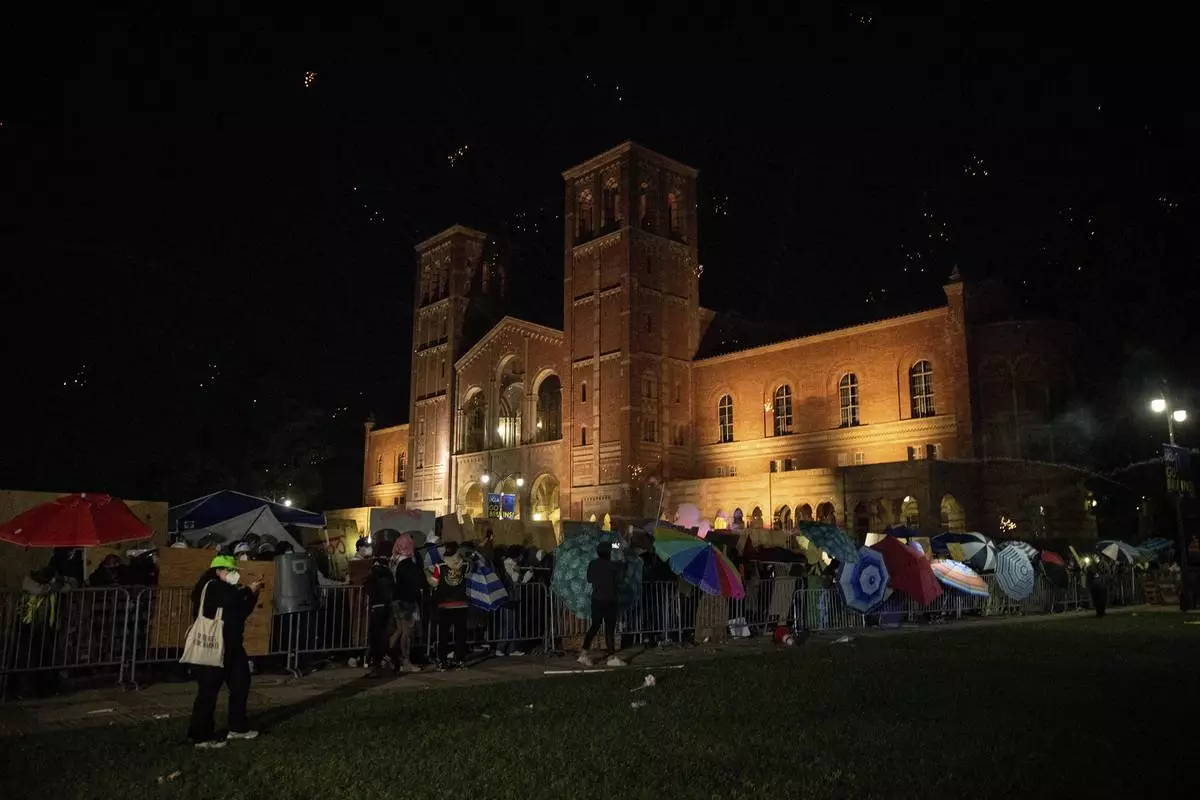
Fireworks erupt as demonstrators clash at a pro-Palestinian encampment at UCLA late Tuesday, April 30, 2024, in Los Angeles. Dueling groups of protesters have clashed at the University of California, Los Angeles, grappling in fistfights and shoving, kicking and using sticks to beat one another. (AP Photo/Ethan Swope)

Demonstrators clash at a pro-Palestinian encampment at UCLA early Wednesday, May 1, 2024, in Los Angeles. Dueling groups of protesters have clashed at the University of California, Los Angeles, grappling in fistfights and shoving, kicking and using sticks to beat one another. (AP Photo/Ethan Swope)

A person looks out as demonstrators clash at a pro-Palestinian encampment at UCLA early Wednesday, May 1, 2024, in Los Angeles. Dueling groups of protesters have clashed at the University of California, Los Angeles, grappling in fistfights and shoving, kicking and using sticks to beat one another. (AP Photo/Ethan Swope)

Demonstrators clash at a pro-Palestinian encampment at UCLA early Wednesday, May 1, 2024, in Los Angeles. Dueling groups of protesters have clashed at the University of California, Los Angeles, grappling in fistfights and shoving, kicking and using sticks to beat one another. (AP Photo/Ethan Swope)
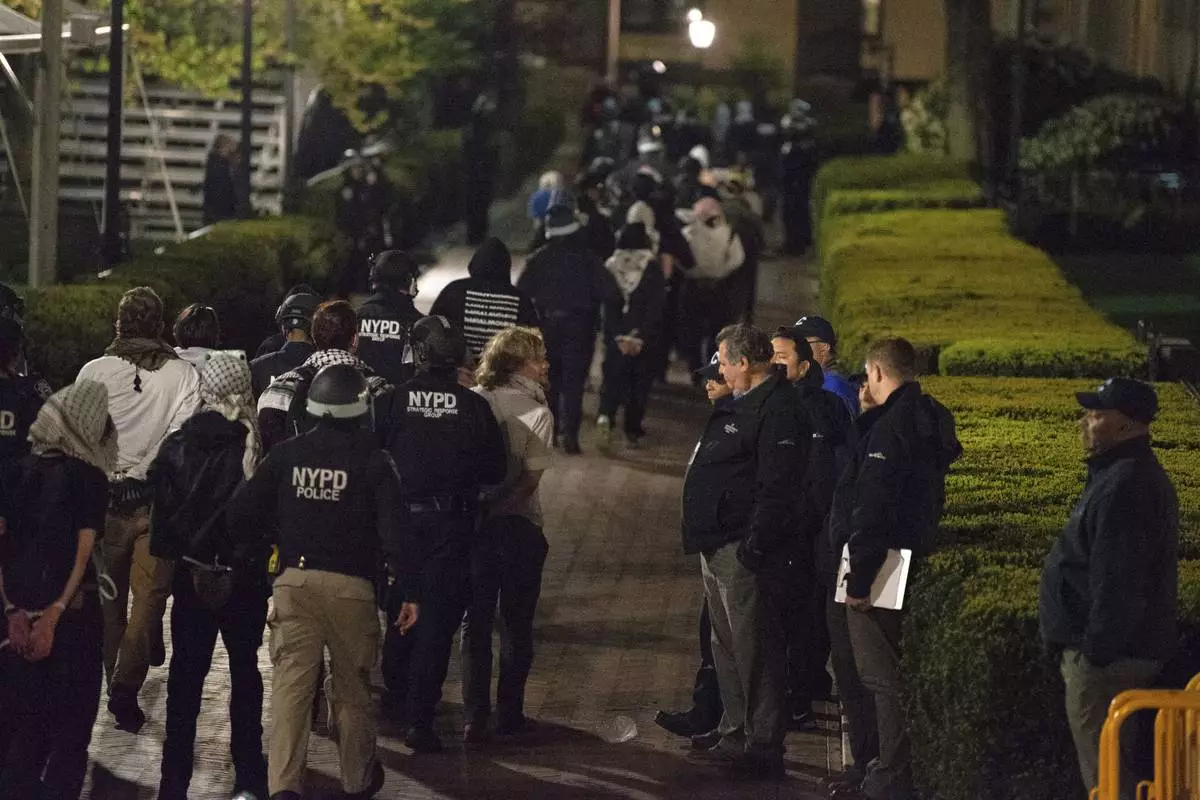
Officers with the New York Police Department arrest pro-Palestinian protesters at Columbia University, Tuesday, April 30, 2024, in New York. The protesters had seized the administration building, known as Hamilton Hall, more than 20 hours earlier in a major escalation as demonstrations against the Israel-Hamas war spread on college campuses nationwide. (Marco Postigo Storel via AP)

Officers with the New York Police Department arrest Pro-Palestinian protesters at Columbia University, Tuesday, April 30, 2024, in New York. The protesters had seized the administration building, known as Hamilton Hall, more than 20 hours earlier in a major escalation as demonstrations against the Israel-Hamas war spread on college campuses nationwide. (Marco Postigo Storel via AP)

Officers with the New York Police Department raid the encampment by pro-Palestinian protesters at Columbia University on Tuesday, April 30, 2024, in New York. The protesters had seized the administration building, known as Hamilton Hall, more than 20 hours earlier in a major escalation as demonstrations against the Israel-Hamas war spread on college campuses nationwide. (Marco Postigo Storel via AP)

Officers with the New York Police Department raid the encampment by pro-Palestinian protesters at Columbia University, Tuesday, April 30, 2024, in New York. The protesters had seized the administration building, known as Hamilton Hall, more than 20 hours earlier in a major escalation as demonstrations against the Israel-Hamas war spread on college campuses nationwide. (Marco Postigo Storel via AP)

Pro-Palestianian protesters gather near a main gate at Columbia University in New York, Tuesday, April 30, 2024, just before New York City police officers cleared the area after a building was taken over by protesters earlier in the day. The building and a tent encampment were cleared during the operation. (AP Photo/Craig Ruttle)




